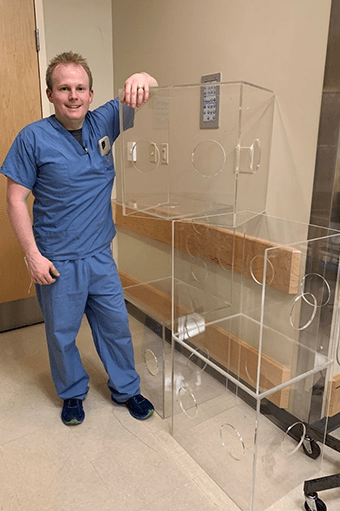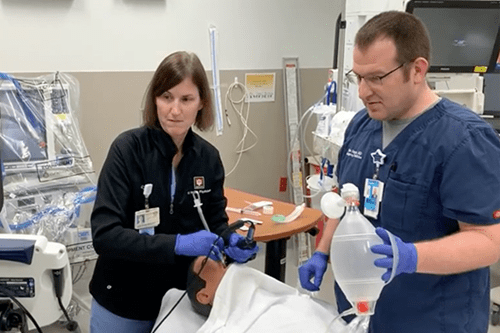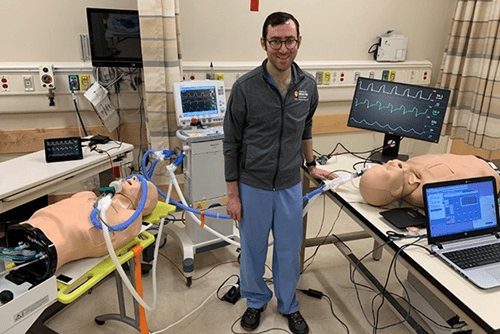Photo: simulated difficulty airway with Drs. Steve Wipprecht and Dylan Cooper
Coauthored by Dylan Cooper, MD, Julie Welch, MD, and Kari Lemme, MD
While COVID-19 has brought sickness and stress to the healthcare system, it has also provided opportunity for innovation and collaboration. The Simulation Center at Fairbanks Hall, led by Dr. Dylan Cooper, Professor of Clinical Emergency Medicine, has taken on this challenge to deliver on service, education, and research in the battle against this pandemic.
Service
The Simulation Center adapted quickly to the evolving needs of the academic health center and has been able to diversify its scope to assist in the newfound challenges with COVID 19. When IU Health Methodist ICU nurses and physicians, including Dr. Tim Ellender, needed to quickly convert a prior inpatient pediatric ward into a new adult ICU floor, the Simulation Center loaned hospital beds and equipment from their virtual hospital. Next, one of the standardized patient trainers, Karen Dutton, has been using her nursing training and experience to staff the IU Health COVID virtual screening clinic. Finally, innovations coordinator, Johnny Cartwright, has tirelessly built and modified intubation boxes to protect physicians during high risk COVID aerosolizing procedures. With the support of the Department of Anesthesia and Eli Lilly, he has been able to supply these boxes to hospital inpatient settings across the IU Health system.

Photo: Johnny Cartwright with his intubation boxes
Education
With an increased need to hire and onboard inpatient bedside nurses, IU Health and the Simulation Center have ramped up nursing orientation to weekly sessions. Simulation faculty and staff, including Dr. Rami Ahmed, have partnered with the Emergency Response Training Institute (ERTI) to deliver in-situ mock codes at University Hospital. Additionally, in collaboration with IU Health and Eskenazi faculty, multiple videos have been created with mannequins to deliver readily available education on airway management of COVID patients. This team included Drs. Marla Doehring, Tyler Stepsis, Steve Wipprecht, and Dylan Cooper. On the making of the Eskenazi COVID-19 Intubation videos, Dr. Tyler Stepsis writes, “The nice side effect of doing an in-situ sim rather than in sim lab was actually seeing what is in the room and what needed to go. We pretty much stripped the shock rooms to keep as much of the needed stuff from getting thrown out, moved essential meds into the stockroom to keep drawers from getting contaminated, started some downstream thoughts about creating IV start kits, critical care kits, and trauma kits. It also allowed for some trial and error regarding communication in and out of the room.” Dr. Marla Doehring echoed similar praise, “Many of us are visual/tactile learners so eyes on and hands on works well for something like this instead of just reading about it.”
You can check out the COVID-19 intubation videos below:

Photo: Drs. Marla Doehring and Tyler Stepsis demonstrating COVID intubation technique (note: PPE was not used in the demonstration to conserve supply)
Research
Not only is simulation used for education, but it can be used to develop, study and pilot new equipment advances. Over the past few weeks, two independent teams have partnered with the Simulation Center to develop novel ventilator splitting technology, in hopes to expand the healthcare system’s ventilator capacity. This has been the result of collaboration between IU Health, IU School of Medicine, Eskenazi Health, VA Hospital, and Eli Lilly. Shown below is Dr. Tobin Greensweig, ICU fellow and innovator, piloting his vent splitter with two lung simulators at the Simulation Center.

Photo: Dr. Tobin Greensweig with his vent splitter
Through innovation and collaboration with multiple organizations and many professionals, from engineers to technicians to educators to providers, we can nimbly respond when crises arise to improve patient care and save lives.
